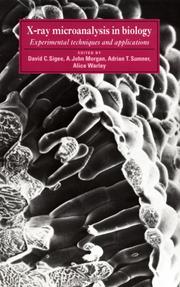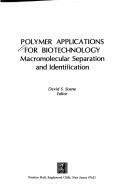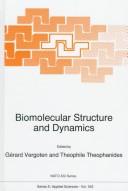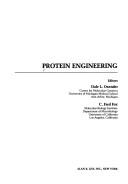| Listing 1 - 10 of 20 | << page >> |
Sort by
|

ISBN: 0521415306 Year: 1993 Publisher: Cambridge Cambridge University Press
Abstract | Keywords | Export | Availability | Bookmark
 Loading...
Loading...Choose an application
- Reference Manager
- EndNote
- RefWorks (Direct export to RefWorks)
Spectrometric and optical chemical analysis --- fysicochemie --- Biological microscopy --- X-ray microanalysis --- Biology --- -X-ray microanalysis --- 57.088 --- Microprobe analysis --- Life sciences --- Biomass --- Life (Biology) --- Natural history --- Technique --- Special methods and techniques for studing biological molecules. Separation. Centrifuging. X-ray study. Radioisotope methods --- 57.088 Special methods and techniques for studing biological molecules. Separation. Centrifuging. X-ray study. Radioisotope methods
Dissertation
ISBN: 9064646791 Year: 2003 Publisher: Wageningen Ponsen en Looijen
Abstract | Keywords | Export | Availability | Bookmark
 Loading...
Loading...Choose an application
- Reference Manager
- EndNote
- RefWorks (Direct export to RefWorks)
57.086 --- 57.088 --- Cytological and histological techniques --- Special methods and techniques for studing biological molecules. Separation. Centrifuging. X-ray study. Radioisotope methods --- Theses --- 57.088 Special methods and techniques for studing biological molecules. Separation. Centrifuging. X-ray study. Radioisotope methods --- 57.086 Cytological and histological techniques
Dissertation

ISBN: 9789086491223 Year: 2007 Publisher: Leuven K.U.Leuven. Faculteit Wetenschappen
Abstract | Keywords | Export | Availability | Bookmark
 Loading...
Loading...Choose an application
- Reference Manager
- EndNote
- RefWorks (Direct export to RefWorks)
In het verleden werd de opdeling van de zoogdierneocortex in afgelijnde gebieden reeds uitvoerig bestudeerd. Corticale areas blijken zowel functioneel, anatomisch als biochemisch te verschillen. Hun onderling zeer gestructureerde samenwerking laat zoogdieren complexe gedragspatronen toe, aangepast aan hun omgeving en habitat. Verschillende technieken werden reeds aangewend om de onderverdeling in corticale areas op te helderen, maar hebben echter nooit geleid tot een consensus of representatieve kaart van de hersencortex, en dit tengevolge van variaties in meetmethode, het kenmerk dat de techniek specifiek bestudeert, en het feit dat resultaten bekomen voor een bepaald species niet zonder beperkingen kunnen overgezet worden naar andere species. Nieuwe areale moleculaire merkers en hun specifieke distributie zijn een uitgelezen manier om deze restricities te omzeilen. Dit onderzoekswerk introduceerde dan ook de ‘protein profiling’ benadering in het domein van de neuroanatomie. Genoom karakterisatie werd reeds omstandig toegepast. We verlegden echter de nadruk van het onderzoek van genen naar eiwitten, gezien proteïnen de actieve moleculen zijn in alle moleculaire en cellulaire processen. Fluorescente twee-dimensionale differentiële gel elektroforese of 2-D DIGE werd, in combinatie met massaspectrometrie, gebruikt om nieuwe areale merkerproteïnen te ontdekken. De geldigheid, betekenis en bruikbaarheid van potentiële merkers werd bekrachtigd aan de hand van immunocytochemie op eiwitniveau en in situ hybridizatie op mRNA niveau. In een eerste reeks experimenten werd met 2-D DIGE de eiwitexpressie vergeleken van drie functioneel verwante corticale gebieden, namelijk areas 17, 18 en 19 van de visuele cortex van de kat. Vijftien spots konden opgemerkt worden als zijnde differentieel, en werden massaspectrometrisch geïdentificeerd als tien verschillende eiwitten. Uit deze lijst selecteerden we de kleinste subeenheid van het neurofilament proteïne (NFL) als potentiële merker van corticale areas. De differentiële expressie van NFL in de drie visuele areas kon met behulp van immunocytochemie inderdaad gerelateerd worden aan een verschillend distributiepatroon in de corticale lagen van de desbetreffende areas. De area-specifieke verspreiding van NFL bleek het gevolg van variaties in intensiteit van de kleuring, densiteit, type en organizatorische opbouw van NFL-immunoreactieve cellen en vezels. Areas 17, 18 en 19 waren van elkaar te onderscheiden. De grens tussen area 17 en area 18 werd echter eerder gevisualiseerd als een transitie-zone, dan als een scherpe overgang. Om na te gaan of NFL ook betekenis heeft als areale merker in andere species dan de kat voerden we immunocytochemie uit op hersenweefsel van de muis, rat en makaak. Grenzen tussen visuele areas in alle drie deze species konden onderscheiden worden op basis van het distributie patroon van NFL. Dit eerste deel van ons onderzoek bewijst dan ook dat de gecombineerde inzet van 2-D DIGE en massaspectrometrie, met vervolgens validatie van de resultaten op eiwit of mRNA niveau, zeker geschikt is om neurochemische verschillen tussen corticale areas op te pikken, en deze dan te vertalen in area-specifieke ewitpatronen. Aangezien NFL een betrouwbare merker was gebleken in de muis visuele cortex, werd de distributie van het NFL proteïne geanalyseerd doorheen de volledige hersenen van de muis in het coronale en sagittale vlak. De NFL verdeling vertoonde area-specifieke kenmerken in alle corticale gebieden. De grenzen tussen corticale areas konden herkend worden aan de hand van verschillen in laminaire organizatie van NFL immunopositieve neuronale cellichamen en vezels, en waren van scherpe, heldere of transitionele aard. Het groeperen van gelijkaardige area-specifieke patronen leidde tot een classificatie van de NFL verspreiding die zeer goed congrueerde met de classificatie van de areas volgens functionaliteit. Karakteristieke NFL patronen werden waargenomen in de paleocortex, inclusief de anterior cingulate, de insular en de retrospleniale cortex, de sensorische cortex en de motor cortex. NFL immunoreactiviteit levert ons dan ook nieuwe, complementaire informatie wat betreft de opdeling van de cortex van de muis in afgelijnde areas. Deze nieuwe merker kan zeker aangewend worden om locatie en grootte van de verschillende corticale systemen te bepalen in minder gekende zoogdiersoorten. In een volgend deel onderzochten we de eventuele correlatie tussen de area-specifieke NFL eiwitdistributie en de locatie van NFL transcripten of mRNA. Neuronen die NFL transleren werden gelokaliseerd met behulp van in situ hybridizatie. We opteerden hier voor deze techniek omwille van de snelle en betrouwbare resultaten. Ook het NFL mRNA vertoonde een area-specifieke distributie, zodat corticale grenzen konden onderscheiden worden. Niet alle grenzen waren overduidelijk af te lijnen, maar dit doet geen afbreuk aan de toepasbaarheid van deze methodologie, zoals bewezen wordt in het laatste deel. In het finale deel van dit onderzoek brachten we het proteoom van twee primaire sensorische areas van de muis in kaart. Zesentwintig eiwitten werden geïdentificeerd uit 23 spots, als zijnde differentieel tot expressie gebracht in beide regio’s. De kandidaat areale merkers wijken af van het eerder vernoemde resultaat in de kat visuele cortex. CKB en CRMP2 werden geselecteerd en geanalyseerd met behulp van in situ hybridizatie. Corticale grenzen konden bepaald worden aan de hand van de CKB mRNA distributie, terwijl CRMP2 vooral de subcorticale gebieden visualiseerde. Tot slot, we kunnen stellen dat ‘protein profiling’ zeker kan aangewend worden in onderzoek naar neuroanatomische aspecten van neuropathologie en -psychiatrie. Deze technologie kan toegepast worden op andere zoogdierspecies, zoals primaten en de mens. Many studies have been undertaken to acquire full knowledge on the cortical parcellation of the mammalian brain in distinct areas. These functional and anatomical entities are interconnected in a highly-specific manner and enable complex behavior, adjusted to the environment and habitat of the species. Various types of techniques have attempted to reveal the areal parcellation. The different methods used failed however in reaching a consensus about cortical organization due to differences in measurement method, the characteristic they focused on, and the lack of transferability of results to other species. These drawbacks were assumed to be get round by mapping the mammalian cortex with molecular areal marker distribution. The present research study introduces protein expression profiling as a novel approach in neuroanatomical studies. Gene expression profiling has been applied extensively in the past, but we moved the focus to the actual active molecules in all cellular processes and pathways, the proteins. The proteomics technique of 2-D DIGE, combined with mass spectrometry, was applied as screening method for new areal markers, with subsequent validation of their applicability with immunocytochemistry at the protein level and in situ hybridization at the mRNA level. Comparison of the protein content of three visual areas (17, 18 and 19) with 2-D DIGE located fifteen differentially expressed spots. Subsequent mass spectrometry identified ten proteins in these spots, from which we selected the low molecular weight subunit of neurofilament or NFL as potential areal marker. Indeed, we were able to prove a correlation between differential expression levels of NFL to differential laminar distribution patterns in all three visual areas. Immunocytochemistry revealed area-specific NFL protein distribution in the cat visual cortex with differences in staining intensity, cell and fiber density, type and organization. The boundaries between areas 17, 18 and 19 were set, with the 17/18 border as a transitional border-zone rather than a clear or clear-cut border. To assess the value of NFL as areal marker in the visual cortex of other mammalian species we performed immunocytochemistry on rat, mouse and macaque monkey tissue sections. In all three mammalian species, NFL protein distribution allowed setting boundaries between primary and secondary areas and subareas. This first part of the study delivered ‘proof of principle’; 2-D DIGE is adequate to screen for neurochemical differences between cortical areas that are mirrored by area-specific distribution patterns as detectable by immunocytochemistry. Since NFL was proven a valuable, new marker in the mouse visual cortex, we performed immunocytochemistry on coronal sections along the rostro-caudal axis to visualize this protein’s distribution throughout the entire mouse brain. Indeed, NFL protein displayed area-specific expression patterns throughout the entire forebrain. Cortical boundaries were set based on differences in laminar distribution patterns of neuronal cells and fibers. These borders were classified in three types (clear-cut, clear and transitional). When grouping corresponding area-specific patterns, this classification was clearly related to the functionality of cortical systems. We identified characteristic NFL protein outlines in the paleocortex, including the anterior cingulate, the insular and the retrosplenial cortex, the motor cortex and the sensory cortex. Immunoreactivity for NFL grants complementary information on the areal parcellation of the mouse brain, for which until this day exists no consensus brain map. NFL protein distribution opens new perspectives to study position and size of different cortical systems in less understood mammalian species. Next, we investigated if the area-specific expression pattern of the NFL protein could be correlated to an area-specific distribution pattern of the NFL mRNA. Neurons which translate NFL were located by means of in situ hybridization histochemistry as a fast and reliable screening method. Indeed, NFL mRNA appeared in the mouse cortex in an area-specific manner, what allowed cortical delineation. Not all boundaries between abutting regions were perfectly clear, but this presents no drawback on the advantages of in situ hybridization. In the final chapter of the results sections, proteome profiling was performed on two primary sensory areas of the mouse brain. 23 spots were located as differential, and were mass spectrometrically identified as 26 different proteins. The potential areal markers identified differed quite from the earlier identified candidates in the cat visual cortex. CKB and CRMP2 were selected and validated by means of in situ hybridization. While CKB mRNA allowed clear delination of mouse cortical areas, CRMP2 mainly visualized subcortical regions. To conclude, protein expression profiling and thus new areal markers deliver additional information in a fast, reliable and reproducible manner in relation to remaining issues in neuroanatomical research on smaller mammals, but also on complex species, like primates and humans. Verschillende neurologische ziekten, zoals Alzheimer en Parkinson, en psychische aandoeningen zoals autisme, schizofrenie en depressie blijven tot op heden moeilijk of niet te genezen. De ongeneeslijkheid van deze aandoeningen is te wijten aan het gebrek aan voldoende kennis over de onderliggende mechanismen en processen, wat deels het gevolg is van onvoldoende kennis van de hersenanatomie. Zoogdieren, inclusief de mens, vertonen complex gedrag, aangepast aan hun omgeving, en gestuurd vanuit de hersenen. Zo kan de hersenschors van zoogdieren ingedeeld worden in areas die van mekaar verschillen in functie, biochemie en anatomie. Door op een zeer gestructureerde manier samen te werken, ondersteunen de verschillende areas de specifieke gedragingen en capaciteiten van het zoogdier. Echter, er bestaat nog steeds geen duidelijkheid over de precieze ligging en aflijning van deze areas in menig species, ondanks veelvuldige en grondige studies. Zeer uiteenlopende technieken werden gehanteerd, met elk hun eigen nadruk op een bepaald aspect van de hersenanatomie. Recent werd een mogelijke oplossing gezien in het identificeren van moleculaire merkers die deze areas in de hersenen zouden aflijnen door middel van hun specifieke distributie. Onderzoek naar deze merkers werd voornamelijk uitgevoerd op genetisch niveau, en leidde tot identificatie van merkergenen zoals bijvoorbeeld occ1, RBP en H-2Z1. In dit onderzoek verlegden we de nadruk naar het eiwitniveau vermits eiwitten de actieve moleculen zijn in alle cellulaire processen van gelijk welk weefsel. In een eerste stap hanteerden we de populaire fluorescente twee-dimensionele differentiële gel elektroforese techniek om de eiwitinhoud tussen hersenareas te vergelijken om zo eiwitten met een specifiek voorkomen op te sporen. Na identificatie met behulp van massaspectrometrie onderzochten we de correlatie tussen het verschil in hoeveelheid van een bepaald eiwit en zijn regio-specifieke distributie met behulp van immunohistochemische kleuringen. Ook de distributie van het coderende gen werd bestudeerd met behulp van in situ hybridizatie. Uiteindelijk werden drie verschillende nieuwe merkers ontdekt met elk een eigen spreiding in afgelijnde areas van de zoogdierhersenen. Neurofilament Low bleek inzetbaar in alle onderzochte zoogdierspecies en doorheen de ganse hersenschors. Dit doctoraatsonderzoek introduceerde ‘functionele proteomics’ op een succesvolle manier in het domein van de neuroanatomie. Resultaten van deze aanpak vormen een meerwaarde in de studie van de hersenstructuur van zoogdieren, maar ook in de studie van neurologische aandoeningen.
Academic collection --- 591.481.1 --- 57.088 --- 591.481.1 Brain of vertebrates. Encephalon. Cerebellum --- Brain of vertebrates. Encephalon. Cerebellum --- 57.088 Special methods and techniques for studing biological molecules. Separation. Centrifuging. X-ray study. Radioisotope methods --- Special methods and techniques for studing biological molecules. Separation. Centrifuging. X-ray study. Radioisotope methods --- Theses

ISBN: 0841209782 Year: 1986 Volume: vol 314 Publisher: Washington American Chemical Society
Abstract | Keywords | Export | Availability | Bookmark
 Loading...
Loading...Choose an application
- Reference Manager
- EndNote
- RefWorks (Direct export to RefWorks)
Biochemistry --- -Biomolecules --- -Biotechnology --- -Chemical engineering --- Genetic engineering --- Biological molecules --- Molecules --- Molecular biology --- Biological chemistry --- Chemical composition of organisms --- Organisms --- Physiological chemistry --- Biology --- Chemistry --- Medical sciences --- Technique --- -Congresses --- Purification --- Composition --- -Technique --- Biomolecules --- Biotechnology --- Chemical engineering --- Technique&delete& --- Congresses --- Purification&delete&

ISBN: 9027718490 9789027718495 9400964927 9400964900 Year: 1984 Volume: vol 139 Publisher: New York London Plenum Press
Abstract | Keywords | Export | Availability | Bookmark
 Loading...
Loading...Choose an application
- Reference Manager
- EndNote
- RefWorks (Direct export to RefWorks)
Biomolecules --- Analysis --- Spectra --- Spectrum Analysis, Raman. --- Molecular Biology. --- Biochemical Genetics --- Biology, Molecular --- Genetics, Biochemical --- Genetics, Molecular --- Molecular Genetics --- Biochemical Genetic --- Genetic, Biochemical --- Genetic, Molecular --- Molecular Genetic --- Genetic Phenomena --- Analysis, Raman Spectrum --- Raman Optical Activity Spectroscopy --- Raman Scattering --- Raman Spectrum Analysis --- Raman Spectroscopy --- Scattering, Raman --- Spectroscopy, Raman --- Biological molecules --- Molecules --- Molecular biology --- spectroscopy --- biological molecules --- NATO --- Spectrum Analysis, Raman --- Molecular Biology --- Spectrum analysis --- Congresses --- Biomolécules. Analyse. (Congrès) --- Biomoleculen. Analyse. (Congres)

ISBN: 3527260455 Year: 1984 Volume: 5 Publisher: Weinheim : VCH,
Abstract | Keywords | Export | Availability | Bookmark
 Loading...
Loading...Choose an application
- Reference Manager
- EndNote
- RefWorks (Direct export to RefWorks)
Peptidases --- Protéase --- Proteases --- Inhibiteur d'enzyme --- Enzyme inhibitors --- Enzymes --- 577.152.34 --- 57.088 --- analysis. --- Acting on peptide bonds (peptide hydrolases), proteolytic fermentation. Proteinases --- Special methods and techniques for studing biological molecules. Separation. Centrifuging. X-ray study. Radioisotope methods --- 57.088 Special methods and techniques for studing biological molecules. Separation. Centrifuging. X-ray study. Radioisotope methods --- 577.152.34 Acting on peptide bonds (peptide hydrolases), proteolytic fermentation. Proteinases --- analysis --- Enzymology --- Inhibitor

ISBN: 0136832512 Year: 1992 Volume: vol *2 Publisher: Hertfordshire Prentice Hall
Abstract | Keywords | Export | Availability | Bookmark
 Loading...
Loading...Choose an application
- Reference Manager
- EndNote
- RefWorks (Direct export to RefWorks)
Polymeren in de biotechnologie --- Polymers in biotechnology --- Polymères en biotechnologie --- Biomolecules --- -Biotechnology --- -Polymers --- -#KVIV:BB --- Polymere --- Polymeride --- Polymers and polymerization --- Macromolecules --- Chemical engineering --- Genetic engineering --- Biological molecules --- Molecules --- Molecular biology --- Separation --- Methodology --- Biotechnology --- Polymers --- Separation. --- Methodology. --- Biotechnology. --- #KVIV:BB --- Materials --- Analysis

ISBN: 0792346335 9401063079 9401154848 9780792346333 Year: 1997 Volume: 342
Abstract | Keywords | Export | Availability | Bookmark
 Loading...
Loading...Choose an application
- Reference Manager
- EndNote
- RefWorks (Direct export to RefWorks)
Biomolecular Structure and Dynamics describes recent fundamental advances in the experimental and theoretical study of molecular dynamics and stochastic dynamic simulations, X-ray crystallography and NMR of biomolecules, the structure of proteins and its prediction, time resolved Fourier transform IR spectroscopy of biomolecules, the computation of free energy, applications of vibrational CD of nucleic acids, and solid state NMR. Further presentations include recent advances in UV resonance Raman spectroscopy of biomolecules, semiempirical MO methods, empirical force fields, quantitative studies of the structure of proteins in water by Fourier transform IR, and density functional theory. Metal-ligand interactions, DFT treatment of organometallic and biological systems, and simulation vs. X-ray and far IR experiments are also discussed in some detail. The book provides a broad perspective of the current theoretical aspects and recent experimental findings in the field of biomolecular dynamics, revealing future research trends, especially in areas where theoreticians and experimentalists could fruitfully collaborate.
Molecular dynamics --- Biomolecules --- Congresses. --- Structure --- Congresses --- Biophysics. --- Biological physics. --- Chemoinformatics. --- Physical chemistry. --- Biological and Medical Physics, Biophysics. --- Computer Applications in Chemistry. --- Physical Chemistry. --- Chemistry, Theoretical --- Physical chemistry --- Theoretical chemistry --- Chemistry --- Chemical informatics --- Chemiinformatics --- Chemoinformatics --- Chemistry informatics --- Information science --- Computational chemistry --- Biological physics --- Biology --- Medical sciences --- Physics --- Data processing --- Biological molecules --- Molecules --- Molecular biology --- Molecular dynamics - Congresses. --- Biomolecules - Structure - Congresses.

ISBN: 084514300X 9780845143001 Year: 1987 Volume: vol *2 Publisher: New York, N.Y. Liss
Abstract | Keywords | Export | Availability | Bookmark
 Loading...
Loading...Choose an application
- Reference Manager
- EndNote
- RefWorks (Direct export to RefWorks)
Biological techniques --- Biochemical engineering --- Molecular biology --- Protein engineering --- Genetic engineering --- Proteins --- GENETIC ENGINEERING --- analysis --- genetics --- Genetic Engineering. --- 577.112 --- 57.088 --- Engineering, Protein --- Protein design --- Designed genetic change --- Engineering, Genetic --- Gene splicing --- Genetic intervention --- Genetic surgery --- Genetic recombination --- Biotechnology --- Transgenic organisms --- Intervention, Genetic --- Genetic Intervention --- Genetic Interventions --- Interventions, Genetic --- Cloning, Molecular --- DNA, Recombinant --- Industrial Microbiology --- Artificial Gene Fusion --- Organisms, Genetically Modified --- Animals, Genetically Modified --- Plants, Genetically Modified --- analysis. --- genetics. --- Special methods and techniques for studing biological molecules. Separation. Centrifuging. X-ray study. Radioisotope methods --- Design --- Genetic engineering. --- Protein engineering. --- Genetic Intervention. --- 57.088 Special methods and techniques for studing biological molecules. Separation. Centrifuging. X-ray study. Radioisotope methods --- 577.112 Proteins --- Genetic Engineering --- Proteïnen. (Versch. onderwerpen) --- Ingenieurskunst / in de biologie. --- Génie génétique. (Mélanges) --- Protéines. (Mélanges) --- Art de l'ingénieur / en biologie. --- Genetische ingenieurskunst. (Versch. onderwerpen) --- Proteins - analysis --- Proteins - genetics
Book
ISBN: 0878932801 0878932798 Year: 1990 Publisher: Sunderland Sinauer Associates
Abstract | Keywords | Export | Availability | Bookmark
 Loading...
Loading...Choose an application
- Reference Manager
- EndNote
- RefWorks (Direct export to RefWorks)
Systematics. Taxonomy. Nomenclature --- Molecular biology --- Biology --- Biologie moléculaire --- Classification --- Research --- Methodology --- Méthodologie --- Chimiotaxonomie --- chemotaxonomy --- Échantillonnage --- Sampling --- ADN --- DNA --- Acide nucléique --- Nucleic acids --- Phylogénie --- Phylogeny --- Cytogénétique --- cytogenetics --- Plante --- plants --- methodology --- 57.06 --- 57.088 --- Nomenclature and classification of organisms. Taxonomy --- Special methods and techniques for studing biological molecules. Separation. Centrifuging. X-ray study. Radioisotope methods --- Molecular aspects. --- SYS General Systematics --- general systematics --- 57.088 Special methods and techniques for studing biological molecules. Separation. Centrifuging. X-ray study. Radioisotope methods --- 57.06 Nomenclature and classification of organisms. Taxonomy --- Biologie moléculaire --- Méthodologie --- Life sciences --- Biomass --- Life (Biology) --- Natural history --- Classification&delete& --- Molecular aspects --- Biology - Classification - Research. --- Molecular biology - Methodology. --- Research. --- Molecular systematics --- MOLECULAR BIOLOGY --- CHEMOTAXONOMY --- RESEARCH --- MOLECULAR SYSTEMATICS --- METHODS --- HANDBOOKS
| Listing 1 - 10 of 20 | << page >> |
Sort by
|

 Search
Search Feedback
Feedback About UniCat
About UniCat  Help
Help News
News